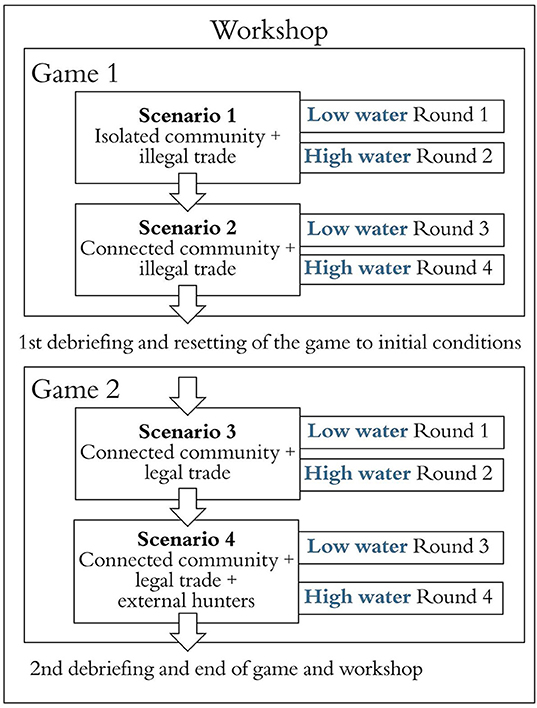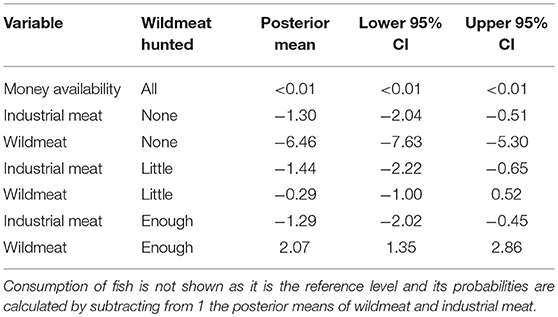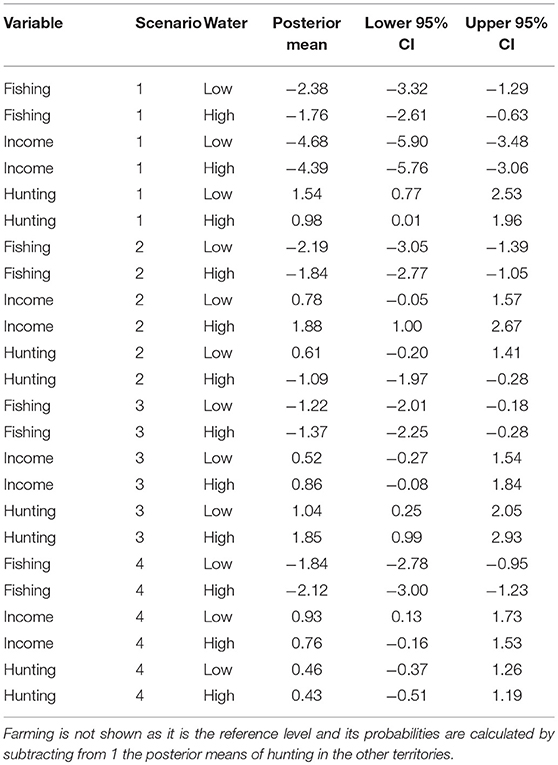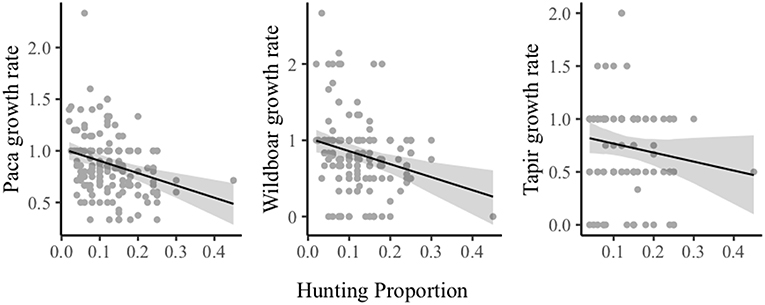- 1Forest Management and Development group, Institute of Terrestrial Ecosystems, Department of Environmental System Science, Swiss Federal Institute of Technology (ETH), Zurich, Switzerland
- 2Center for International Forestry Research (CIFOR), Bogor, Indonesia
- 3CIRAD, UR Forest and Societies, Montpellier, France
Despite growing industrialization, the shift to a cash economy and natural resource overexploitation, indigenous people of the Amazon region hunt and trade wildlife in order to meet their livelihood requirements. Individual strategies, shaped by the hunters' values and expectations, are changing in response to the region's economic development, but they still face the contrasting challenges of poverty and overhunting. For conservation initiatives to be implemented effectively, it is crucial to take into account people's strategies with their underlying drivers and their adaptive capabilities within a transforming socio-economic environment. To uncover hunting strategies in the Colombian Amazon and their evolution under the current transition, we co-designed a role-playing game together with the local stakeholders. The game revolves around the tension between ecological sustainability and food security—hunters' current main concern. It simulates the mosaic of activities that indigenous people perform in the wet and dry season, while also allowing for specific hunting strategies. Socio-economic conditions change while the game unfolds, opening up to emerging alternative potential scenarios suggested by the stakeholders themselves. Do hunters give up hunting when given the opportunity of an alternative income and protein source? Do institutional changes affect their livelihoods? We played the game between October and December 2016 with 39 players—all of them hunters—from 9 different communities within the Ticoya reserve. Our results show that providing alternatives would decrease overall hunting effort, but impacts are not spatially homogenous. Legalizing trade could lead to overhunting except when market rules and competition come into place. When it comes to coupled human-nature systems, the best way forward to produce socially just and resilient conservation strategies might be to trigger an adaptive process of experiential learning and scenario exploration. The use of games as “boundary objects” can guide stakeholders through the process, eliciting the plurality of their strategies, their drivers and how outside change affects them.
Introduction
In the tropical Anthropocene, hunting, and the trade of wildlife still play a crucial role in the livelihoods of rural communities (van Vliet, 2011; WHO and CBD, 2015; Nielsen et al., 2018). More than 150 million households in Asia, Africa and Latin America rely to some extent on wildmeat to meet their dietary requirements and support their economies (Nielsen et al., 2018). Tropical forest productivity for wildmeat is generally lower than in open habitats (Robinson and Bennett, 2000). As a result, overhunting is considered a major threat for biodiversity and for the people that depend on it as a source of food and income (Bennett and Robinson, 2000; Milner-Gulland et al., 2003; Ripple et al., 2016). Hunting may have far-reaching consequences on entire habitats, depleting species responsible for key ecosystem functions such as seed dispersion, predation and herbivory (Emmons, 1989; Wright, 2003). The effects are not homogenous on the plant community as hunters tend to target large-bodied vertebrates, which are more likely to disperse large-seeded plants (Peres, 2007; Kurten, 2013). Selective hunting, along with habitat fragmentation, has led many seemingly “pristine” tropical forests to suffer from the “half-empty forest syndrome” (Redford and Feinsinger, 2003).
While there is general consensus on the unsustainability of hunting (Fa et al., 2002; Milner-Gulland et al., 2003; van Vliet et al., 2015b; Ripple et al., 2016; Benítez-López et al., 2017), assessing the impact of harvest remains a challenge. Static sustainability indices and site comparison studies have often proven very sensitive to model parameters and are ultimately not appropriate for measuring the impact of hunting (Ling and Milner-Gulland, 2006; Levi et al., 2009; Weinbaum et al., 2013; van Vliet et al., 2015a). Sustainability studies need to acknowledge the complexity of the hunting system, its spatial and temporal heterogeneity and its inherent human component made of the evolving needs and aspirations of millions of people around the globe (van Vliet et al., 2015b).
Bringing harvest to sustainable levels means integrating both social and environmental components of management as well as their dynamic relationships in modeling efforts (Verburg, 2006). Effective and socially just conservation initiatives should be guided not only by the best available information on the resource but also by a deeper understanding of people's strategies, their drivers and their adaptive capabilities (Feintrenie et al., 2010; Garcia et al., 2010; Bennett et al., 2016). The need for more inclusive, community-based approaches to conservation practice is widely recognized; however, their implementation is still limited and performance remains well-below expectations (Berkes, 2004; Bennett et al., 2017). Centralized command and control approaches that alienate local resource users are still prevalent but tend not to be effective where weak, underfunded institutions fail in enforcing the rules and simultaneously contribute to the marginalization and poverty of rural communities (Brandon et al., 1998; Barrett et al., 2001; Andrade and Rhodes, 2012; Brockington and Wilkie, 2015). The simultaneous lack of enforcement and criminalization of hunting and trade bare the risk of encouraging hidden practices that—because of their illegality—evade institutional control and restrictions (Nasi et al., 2008; Duffy et al., 2016).
This reflects the current situation in Colombia where, despite trade prohibition, wildmeat can be found in the markets of rural as well as urban centers around the country (van Vliet et al., 2014a). Decree 2811 from 1974 allows hunting of non-protected species outside protected areas as long as it is for the subsistence of the hunter and her or his family. For trading, independently of the scale and purpose, hunters need an official license, which is extremely complex if not impossible to get for members of rural communities (van Vliet and Gomez, 2015). The institutional definition of subsistence in the legal framework considers only food safety. Against this narrow definition, the local concept of subsistence includes other needs linked to housing, education and health, which can be covered through trading part of the wildmeat. Despite its history of strict conservations and the foreseen implementation challenges, the current political debate in Colombia is favorable to sustainable use models (van Vliet, 2016).
The Ticoya indigenous reserve, in southern Colombia, serves as an example of these processes. The reserve's local economy relies mainly on shifting cultivation. The main staple crops yucca, plantain and corn are protein-poor and people complement their diet by fishing and to a lesser extent by hunting (Eden, 1990; Maldonado, 2010; van Vliet et al., 2014b). Despite its relative remoteness, the region is undergoing significant socio-economic changes at an exceptionally high rate. Economic development is affecting people' diets as well. Processed food products coming from Southern Brazil, the Peruvian Andes and other areas of Colombia can now be easily found in the reserve (van Vliet et al., 2014b). Because of all these factors, local communities are relying more and more on the cash economy and industrialized products. At the same time, their cultural identity and indigenous rights over land and political autonomy are increasingly acknowledged (van Vliet et al., 2018). Yet in this emerging globalized society, local communities still rely on their surrounding forest and—among other activities—do hunt and trade wildlife in order to meet their livelihood requirements (Bodmer and Lozano, 2001; van Vliet et al. 2015d; Bennett et al., 2016).
To ensure food security and strengthen cultural identity, local hunters have created in 2016 Colombia's first indigenous hunters' association: Airumaküchi (van Vliet, 2016). One of Airumaküchi's first objectives is to work toward sustainable use of wildlife and it is therefore in their own interest to uncover hunters' strategies, with their driving values and aspirations. This would not only urge institutions to acknowledge their effort and adapt the legal framework for subsistence trade, but it is also changing the way hunters are perceived by society.
Given the persistence of hunting and trading in Colombia, the challenges to sustainability and the openness of the national government toward sustainable use, there is a need to better understand hunters' decisions to ensure that future conservation initiatives have the desired ecological and social outcomes. Airumaküchi and our research team co-designed a role-playing game—named TICOYA —to initiate and support a learning and collective decision-making process around hunters' most relevant issue: how can they hunt sustainably, ensuring biodiversity conservation, and food security under current and future socio-economic conditions? We developed the game following the Companion Modeling (ComMod) approach (Étienne, 2013). We used the game to elicit hunters' strategies and their underlying reasons under different scenarios. The design of the scenarios was guided by two hypotheses:
1. Providing hunters with income and diet alternatives will reduce their harvest of wildmeat. This hypothesis is based on the assumption that pressure on natural resources is linked to poverty and a lack of alternative options (Brown, 2002), although the impact of alternative livelihood projects are unclear or rarely documented (Roe et al., 2015).
2. Legalizing trade will not trigger an increase in hunting pressure because trade already occurs through hidden channels and because hunters in Ticoya hunt for subsistence—as defined locally—and not for commercial purposes.
These two hypotheses led to the formulation of four scenarios. We specifically explore what drives hunters' decisions when (1) communities are isolated and wildmeat trade is illegal, (2) communities have access to income and diet alternatives and trade is illegal, (3) communities have access to alternatives and trade is legal and finally (4) trade is legal and competition is higher due to the intrusion of external hunters. A more detailed description of the scenarios is given in the Materials and Methods section.
Games, particularly role-playing games, help stakeholders shed light on complex socio-ecological systems, their internal dynamics and feedback mechanisms and the multiplicity of perceptions (Basco-Carrera et al., 2017; Reibelt et al., 2017; Redpath et al., 2018). Confronting players with their actions and their impacts not only fosters understanding but also contributes to strategic management, supporting people to think adaptively and creatively in the face of the challenges encountered in the game that reflect those of the real world (Barreteau et al., 2011; Speelman et al., 2017). Within this context, role-playing games follow a constructivist approach that does not aim at finding definitive solutions but at triggering an adaptive process of collective learning, exploration and experimentation (Xiang, 2013; Redpath et al., 2018). Games and simulations have already been used to explore hunters' behavior in different contexts (Bousquet et al., 2001; Mathevet et al., 2007; Le Page et al., 2015; Bodonirina et al., 2018; Marrocoli et al., 2018). To our knowledge, this is the first study that looks at the effects of livelihood and policy interventions within a setting codesigned by the local hunters and the research team.
Materials and Methods
Study Area
The study was conducted in the Colombian department of Amazonas, a strip of land that stretches between Brazil and Perú. The area, part of the so-called tri-frontier, stands out as a dynamic region, where people, cultures, and goods flow ceaselessly across the few roads and the many rivers (Schor and da Costa Avelino, 2017). Specifically, this work was performed within the boundaries of the Ticoya indigenous reserve and along the Leticia-Tarapacá road (Figure 1). The reserve (140 623 Ha) comprises a total of 22 communities located along the banks of the Amazon, Loretoyacu, Amacayacu, Boyahuazu, and Atacuari rivers. It was established in 1990 through INCORA Resolution 021 (Ruiz, 2008) and is home to several indigenous ethnic groups, mainly Ticunas, Cocamas and Yagua—the Ticunas being the most numerous (Riaño, 2003; INEI, 2010). Amazonian indigenous groups as well as non-indigenous people (colonos and mestizos) have converged on the area during the past century, attracted by a series of economic booms (such as rubber, pelt, coca) or because they were displaced from their original settlements (Ortiz, 1984; INEI, 2010). A section of the Ticoya territory is shared with Amacayacu National Park (ANP), which covers 293,500 Ha between the Amacayacu river and the border with Peru (Franco, 2006). Most of the Ticoya reserve is forested area classified according to the rivers' flooding regimes: the varzea forest is seasonally flooded by nutrient-rich water, the swamp forest by nutrient-poor waters, while the terra firme forest is never flooded (Moreno Arocha, 2014). Such a forest mosaic sustains a rich and diversified fauna which has been described mainly within the Amacayacu park (PNNA, 2006; Maldonado, 2010). Outside the park borders, information on wildlife richness and abundance originates mainly from hunters' offtakes and markets (van Vliet et al., 2014a,c; Sandrin et al., 2016). Birds represent the most diverse vertebrate group, with more than 450 species present. Among the most detected are birds of the Cracidae family such as the nocturnal curassow (Nothocrax urumutm—least concern) and the helmeted curassow (Pauxi Pauxi—endangered). Within the reptiles, both caimans—such as the spectacled caiman (Caiman crocodilus—least concern) and tortoises—such as the yellow-footed tortoise (Chelonoidis denticulate—vulnerable) are present in the region. The most numerous group of mammals is represented by rodents, with the lowland paca (Cuniculus paca—least concern) and the black agouti (Dasyprocta fuliginosa—least concern) being rather common—and hunted—species. At least three species of armadillos are present, including the giant armadillo (Priodontes maximus—vulnerable) and about 12 species of primates such as the common wooly monkey (Lagothrix lagotricha—vulnerable). Among the largest and most valued mammals are the white-lipped peccary (Tayassu pecari—vulnerable), the collared peccary (Pecari tajacu—least concern), the red brocket (Mazama americana —data deficient), the gray brocket (Mazama gouazoubira—least concern) and the lowland tapir (Tapirus terrestris—vulnerable).
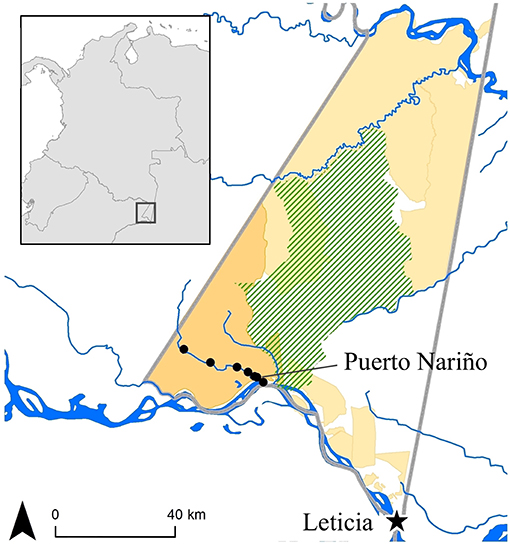
Figure 1. Map of the Ticoya indigenous reserve (in dark orange) and its location in Colombia. Dots indicate the communities where the study was conducted, from right to left: Puerto Esperanza, Puerto Nariño, Ticoya, Santa Teresita, San Francisco, Doce de Octubre, and Tipisca. In green, partly overlapping the Ticoya reserve, the Amacayacu National Park. One workshop was organised in the proximity of Leticia along the National Route 85.
The main settlement of the Ticoya reserve—and second largest municipality in the department after Leticia—is Puerto Nariño. The inhabitants of the communities surrounding Puerto Nariño as well as Leticia, base their subsistence mainly on farming and fishing (Eden, 1990; Trujillo, 2008; Maldonado, 2010). Additional income is gained from the illicit trade of coca and other forest products (mainly cedar—Cedrela spp) and from the expanding tourism industry (Zárate and Ahumada, 2008). Though to a lesser extent compared to the other activities, wildmeat hunting and trade significantly contribute to the local economy as well as to the people's diets (van Vliet et al., 2015c). Irrespective of the purpose, any kind of trading is illegal and hunters run the risk of paying fines and having their catch confiscated every time they sell wildmeat. Despite the prohibition, about 43% of the catch is sold, mainly to neighbors within the same community and occasionally to restaurants, schools, army soldiers and retailers (Quiceno-Mesa et al., 2014). Animals traded are mainly mammals (60%), birds (26%), and reptiles (14%). Most hunters use rifles for hunting although other techniques such as traps, hunting with dogs and—to a minor extent—blowpipes are also used (Sandrin et al., 2016). Rifles, as well as munitions, are mostly illegally sourced but they are generally tolerated if they are not carried around in the urban centers.
Game Development
The game used in this study has been developed jointly by the research team and the local hunters, following the ComMod approach (Etienne, 2014). ComMod is an iterative, participatory modeling approach based on the assumption that participation of the local actors in the model design benefit not only the actors themselves but also the researchers and the decision-makers.
Researchers and hunters repeatedly met in two field missions in 2016 and 2017 to (1) understand and agree upon the main issues at stake, (2) build a conceptual model identifying the most relevant components in the system and (3) develop and validate a role-playing game that allows stakeholders to discuss creatively and constructively how to address the issues identified. Although the co-design phase (1 and 2) triggers a learning process helping stakeholders to share their own perceptions in order to build a common vision of the socio-ecological system (Bodonirina et al., 2018), we report here on the last phase of the project: the implementation of the validated role-playing game in the field.
The game recreates a simplified reality covering the main dynamics related to hunting as elicited during the ComMod process (Etienne et al., 2011). All game parameters have been calibrated based on information collected during the diagnostic phase through semi-structured interviews, collective workshops and, to a lesser extent, via literature. Stakeholders participated actively to every stage of the process and developed a sense of ownership and commitment toward the objectives of the study. Mutual trust was an essential ingredient for ensuring dialogue, promoting learning, and supporting collective decision-making. The study was done in compliance with the ethical guidelines and principles outlined by the Swiss Commission for Research Partnerships with Developing Countries (Stöckli et al., 2012).
Data Collection
We organized nine workshops at three separate locations with 40 different participants (35 men, 5 women) between October and December 2017 (see Table S1 for more information on participants). The selection of participants was organized by our local partner, the hunting association Airumaküchi. As women are mainly garden hunters (Linares, 1976; Smith, 2005) and rarely engage in long-distance hunting, only five were part of the workshops.
All participants were experienced hunters, with 31 of 40 being members of the association. The total number of hunters active within the Ticoya reserve is not known with accuracy given that the definition of hunter is vague. Most inhabitants of the reserve hunt opportunistically while fishing and farming while only a fraction hunts regularly—except when presented with alternative income activities. The number of members of Airumaküchi—about 50 at the time of the study—is not an exact representation of all active hunters but is a good proxy as the association spent significant effort in promoting its activities throughout the reserve. Moreover, many of the hunter members of Airumaküchi are those who explicitly expressed willingness to work toward a sustainable management plan. A voluntary engagement fosters the building of trust and legitimacy, essential ingredients of a ComMod approach.
Each workshop had a different set of participants, most of them from Puerto Nariño or from close communities along the Loretoyacu river. Only three participants were from another indigenous reserve from the outskirts of Leticia, on the incomplete road to Tarapacá. The communities within the reserve along the Amazon river were not included in this study as their residents rely mainly on fishing. Most of their territory is indeed seasonally flooded by the Amazon river and hunting—except for birds and caimans—is negligible.
Most of the participants were Ticunas (25), while the remaining 15 participants consisted of Yagua (7), Cocamas (3), Muinane (2), Bora (1) and one was a colono who had settled in the region 34 years ago after fleeing from another department of Colombia. All participants spoke fluent Spanish and most were able to write and read, although this was not a prerequisite for playing the game.
Most workshops were organized in Puerto Nariño and the participants were personally informed and invited a few days before by the researchers and members of Airumaküchi. Only two workshops took place in smaller and more remote communities as this was logistically easier for all partners. Traveling expenses were covered and lunch was provided at the end of every workshop for all participants and their families. No additional compensation was given.
Workshop Structure
Every workshop followed the same structure (Figure 2). First, a facilitator explained the players' targets and the rules of the game. Then, two successive game sessions were played, each under two different scenarios. Each scenario has two rounds, representing the region's two ecological seasons, characterized as low water and high water. As the workshops were conducted when the level of the Amazon river was at its lowest, the research team always started the games with the low water round. We encapsulated different time scales in one round. While for the players a round represents approximately 1 month within the respective season, and the players need to take decisions within this timeframe, ecologically each round corresponds to the entire season and animals reproduce and move accordingly. As the game progressed, players needed to allocate effort to different activities, possibly go hunting and consume or trade the wildmeat harvested. After that, animals reproduced and moved within the system. At the end of each game totaling four rounds, time was allocated for in-depth debriefings. It is at this stage that game and reality come together (Garcia et al., 2016); the players carefully reflected upon their decisions and the resulting impacts they experienced during the game and connected them with the decisions and practices in their everyday life. Generally, each workshop lasted between 4 and 5 h depending on the debriefing's depth and on the players' commitments.
Game Structure
Each round, players have to fulfill a two-fold objective: a livelihood requirement represented by a specific protein intake (20 kg) and a budgetary (100,000 Colombian Pesos COP) target. These goals are based on the monthly energy and income requirement of a household composed of two adults, two children and one elder (WHO, 1991).
To satisfy their targets, players have at their disposal two currencies. Energy points represent their human capital, with 10 energy points given every turn to each player. Money, fake bank notes with the same denomination as the Colombian Pesos, represents financial capital. Each player receives 70,000 COP. Players have to allocate their energy budget to a combination of different activities: farming, fishing, hunting in four different territories, logging and performing a salaried job to meet their nutritional and income targets. All of them, except hunting and fishing, return immediate monetary rewards. Fishing returns a fixed amount of fish, depending on the amount of energy invested. Hunting is a risky activity and not all hunting trips are successful, the reward will depend on the prey—if any—that is killed. If players choose to allocate part of their energy to hunting, they need to decide whether to hunt in a territory closer or more distant to the village. Traveling—on foot and/or by boat—to a certain territory, spending the night in the forest and using rifles entails a certain cost. The price of hunting—as well as the energy required to perform it—depends on the season, on the territory chosen and on the game scenario (Table 1). The scenarios represent situations reflecting important modalities of the basic assumptions behind the study. A scenario dictates what rules and options (activities) are in play and therefore represent the context to which players will need to respond. The scenarios were developed during the design phase of the project through collective workshops and interviews.
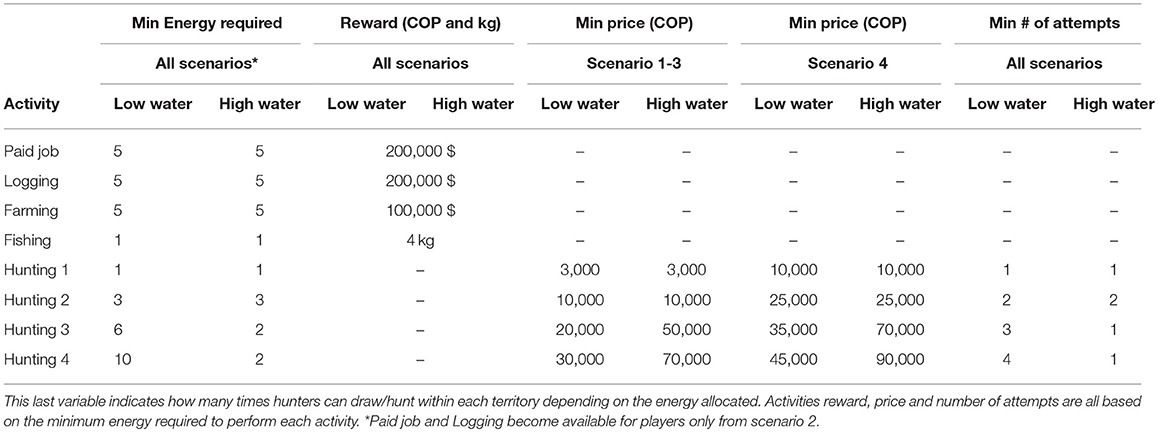
Table 1. The table shows the energy and price required to perform each activity in the game, the respective rewards and, for hunting only, the number of attempts possible.
In scenario 1, players live in a remote community and do not have access to alternative sources of protein or to any paid job. They can only perform subsistence activities (farming, fishing and hunting) and can meet their protein target only by hunting and fishing, or by buying fish or potential excess wildmeat from other players within their community. If players have hunted or fished in excess of their monthly target, they can sell the surplus to other hunters in need or to the local market. As in reality, hunting wildmeat for subsistence purposes is legal, while trading it is illegal. In the game, this means that every time a player wants to sell any excess meat, the game master throws the dice and players run the risk of being caught by the police, having their meat confiscated and being fined. In scenario 2, players live in a connected community and have access to grocery shops that sell industrial meats, and to an alternative source of income, a job offered either by the town council or by a logging company. The former refers to a job performed in town (such as construction worker), the latter one to a job in the forest. Meat trade is still illegal. Scenario 3 represents the situation where the Colombian government changes the requirements for obtaining a commercial hunting license and wildmeat trading becomes legal. This causes certain changes, such as an increase in the price of ammunition, which can now be legally obtained. In scenario 4—the final scenario—the legality of the trade has attracted commercial hunters from elsewhere to converge on the region, thereby creating competition for the local hunters and increased pressure on the animal population. In all scenarios, market prices for fish (5,000 COP/kg), wildmeat (8,000 COP/kg) and, when available, industrial meat (8,000 COP/Kg) do not change. When players trade their catches between them, they can bargain about the price.
The landscape to which the players have access (the gameboard) hosts three animal species moving and reproducing according to species-specific characteristics: the lowland paca (Cuniculus paca), the white-lipped peccary (Tajassu pecari) and the South American Tapir (Tapirus terrestris). These species have been chosen because they are popular game species and because of their different life histories. The paca is a large frugivorous rodent present across the whole Neotropics (Emmons, 2016). It can be encountered both in the forest as well as in the farming areas close to the villages and it is one of the most common species of prey caught by the local hunters (Sandrin et al., 2016). They occupy a relatively small home range and their mass ranges from 7 to 12 kg (Ojasti, 1996). The peccary has similar distribution compared to the paca but a higher weight (25–40 kg) and a much larger home range (Gottdenker and Bodmer, 1998). They are a nomadic species and move in herds of a few individuals up to a few hundreds. The tapir is a large-bodied solitary herbivore and with its 150–250 kg it represents the holy grail for hunters (Robinson and Redford, 1986). It plays a key role in the forest's dynamics as a seed disperser and predator (de Thoisy et al., 2010) and, as the peccary, it is classified as vulnerable by the International Union for Conservation of Nature (IUCN) Red List of Threatened Species (Naveda et al., 2008; Keuroghlian et al., 2013).
The animal population dynamics of these three species are modeled through an agent-based model, which runs in the back in support of the tabletop role-playing game and is used for analytical purposes by the research team. Players do not have any interaction with the computer interface, only with the gameboard, where animals are represented by wooden tokens hidden in four different bags—the hunting territories (Figure 3). Each token represents an animal individual, either male or female. Among the animal tokens there are also “empty” tokens, which indicate when a hunting trip was not successful, either because no animal was encountered, the target was missed, or the rifle failed. The initial probability of success—based on monitoring data from the hunting association—is set at 80% for all territories. If the number of animals in the game fluctuates, so will the probability of encounter. At the suggestion of the hunters, the probability of an encounter will never surpass 80%. There will always be an incompressible uncertainty in hunting, no matter how many animals are in the game. Players do not have any prior knowledge about the animal populations in the bags and can only acquire information by hunting.
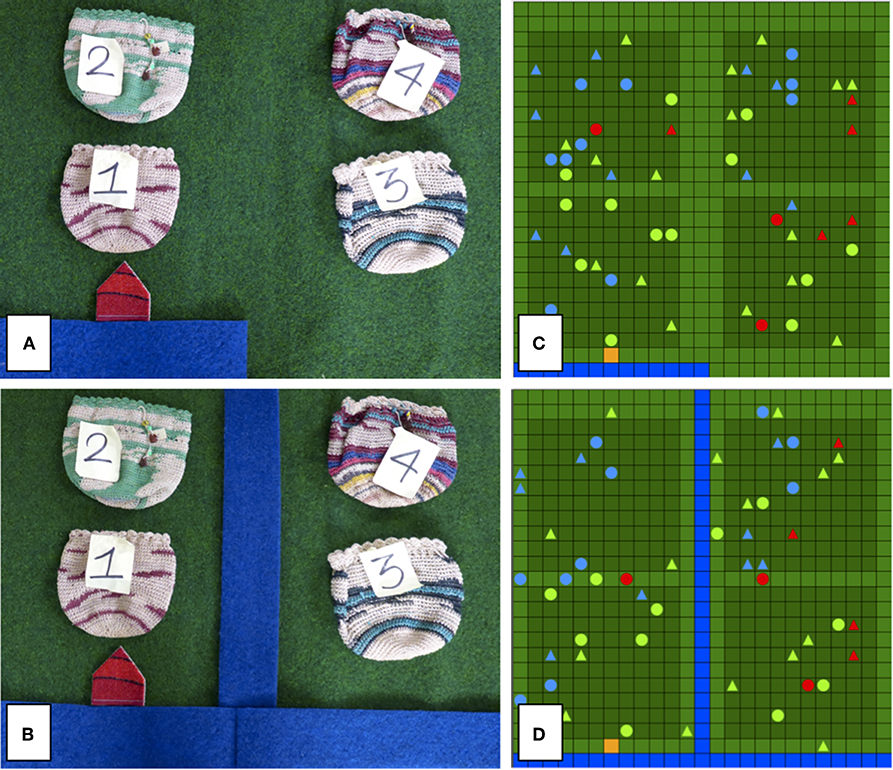
Figure 3. Gameboard during low water (A) and high water (B) season and agent-based model interface during low water (C) and high water (D) season. The colors in the virtual interface represent the different game species: paca (green), peccary (blue), and tapir (red); the shapes distinguish the gender, females (circles), males (triangles).
All individual animals in the game are adults, either female or male. These individuals reproduce when they are found within the same territory, and the abundance of their species is below carrying capacity. Pacas reproduce every season, i.e., twice a year. Each male can reproduce with only one female, generating one offspring with a 50% probability of being either a male or a female. Peccaries reproduce only every other season, i.e., once a year, where each male can mate with a maximum of three females, generating two offspring, each with a 65% probability of being a female. Tapirs also reproduce only every other season, but each male can mate with one female only, generating one offspring, with a 50% probability of being either a male or a female. Irrespective of the species, individuals die only through hunting. There is no natural mortality in our model (Healy, 2017).
In the game, hunting occurs after all players have allocated their energy budgets to the portfolio of available activities and drawn at random one token from the bag corresponding to the chosen territory. There is no ordered game turn, with players following the “first come, first served” principle. We deliberately left this rule flexible to foster discussions among the players about their practices.
When hunters encounter a female of any species, they are asked if they want to know whether the female is pregnant or not. This choice originates from previous workshops where hunters proposed—as a way to reduce the impact of hunting—to ban the killing of pregnant individuals. The research team thus introduced it in the game to stimulate discussion on the applicability of such rule. Killing a pregnant female has impacts on the game population size, structure, and composition. In the game, the consequences of killing a pregnant female translate to non-reproduction of any individuals of the respective species and territory in the current game round. This is an obviously exaggerated effect used to spur the discussion during the debriefing stage. When players encounter a peccary as part of a bigger herd (there are at least four other individuals within the same territory), they are given the option of killing more individuals in the herd, as it is likely to happen in reality. Again, for every female, they must go through the usual set of questions related to its possible pregnancy.
Once hunting is over for all territories, players have to check whether they can meet their protein target with the wildmeat and/or fish they have harvested. If they are still lacking in protein, they can buy wildmeat from other players (if these have a surplus), buy fish from the community market (always available), or, starting from scenario two onwards, they can buy processed meat from the grocery shop. The players will also need to cover their expenses (100,000 COP) using the rewards from the activities or by selling fish or wildmeat either to other players, retailers or the market. It is at this stage that the agent-based model calculates the resulting abundance and distribution of the animals for the next round, and the tokens in the bags are updated accordingly. At every stage of the game, players make their decisions individually, although communication was never formally forbidden and some individual decisions might have been affected by other players. Simplified representations of the game dynamics are depicted in Figures 4 and 5. For a full description, see the Overview-Design-Detail (ODD) protocol in the Supplementary Material.
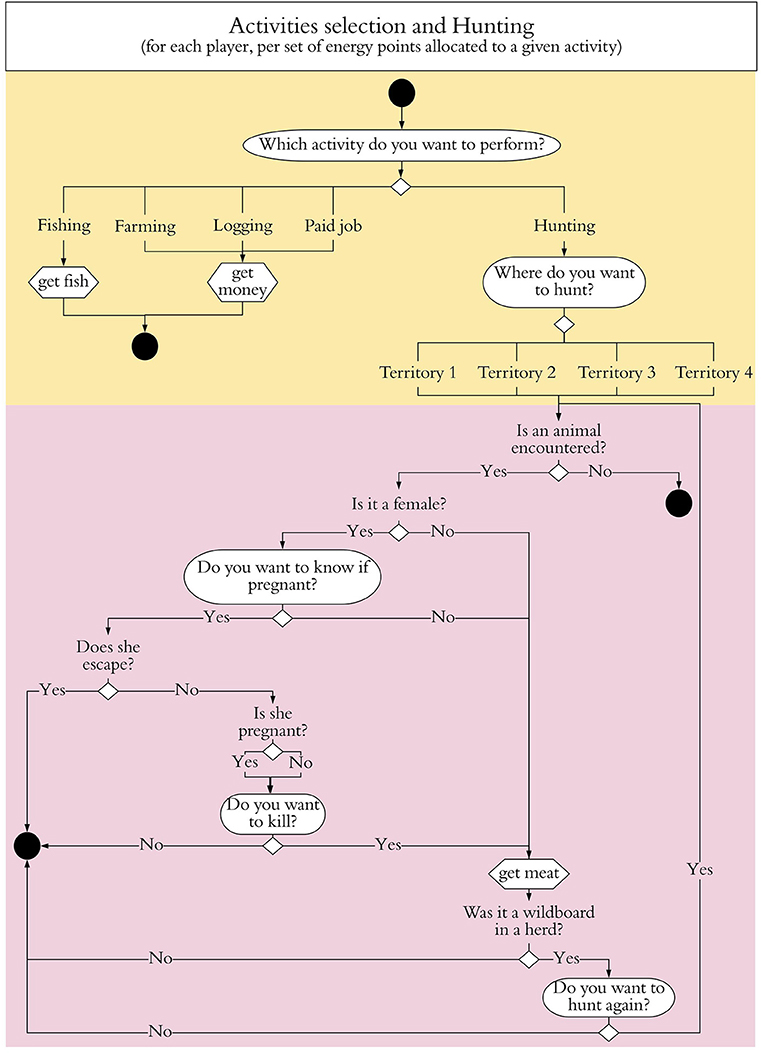
Figure 4. Schematic representation of the game dynamics. The colors correspond to different phases of the game: the allocation of energy to different activities (in yellow) and hunting (in pink). The white round containers indicate questions posed to the players, the hexagonal ones are the game's outcomes.
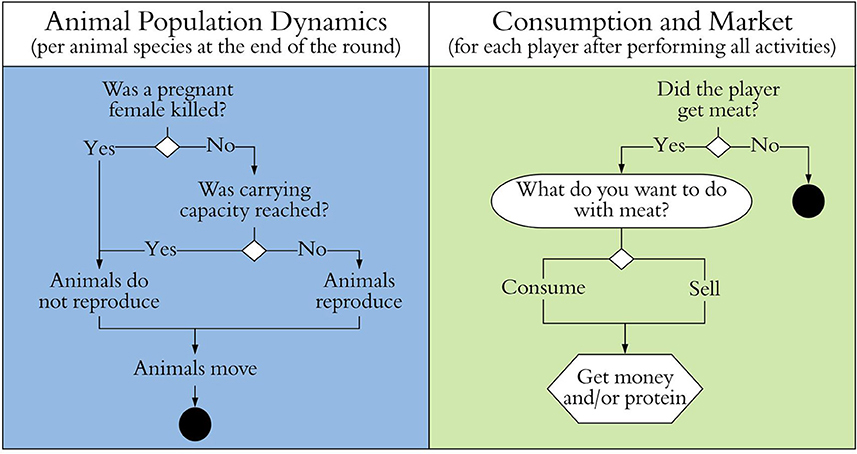
Figure 5. Schematic representation of game dynamics: animal population dynamics (left, in blue) and consumption and market (right, green). The white round containers indicate questions posed to the players, the hexagonal ones are the game's outcomes.
Statistical Analysis
Throughout the game, the research team monitored and recorded the decisions of the players as well as their implications on the abundance and distribution of the three animal species. Players had to decide the following: (1) How to allocate their energy budgets to the available activities (energy budget allocation), (2) where to go hunting (territory selection), (3) what kind of protein to consume (diet composition), and (4) which, if any, protein they wanted to sell (protein reward).
For the analysis of the players' behavioral data, we used a multilevel multinomial logistic regression approach. This method is suitable for the analysis of energy allocation, territory selection, diet composition and protein reward because it accounts for the trade-off-character of these behavioral choices; selecting one behavior precludes performing another (Koster and McElreath, 2017).
We fit multi-response generalized linear mixed models using a Bayesian Monte Carlo Markov Chain (MCMC) approach from the package MCMCglmm (Hadfield, 2010) for R (R Core Team, 2018). The Bayesian framework provides a more flexible alternative for the analysis of hierarchical data compared to a frequentist approach, which is not always effective for the analysis of multivariate or non-normally distributed variables (McCulloch and Searle, 2001; Bolker et al., 2009).
All our multinomial models follow a categorical (generalized Bernoulli) distribution and have response variables of K categories, with one being the reference level with which the other categories are contrasted to. For each model, we fitted three random effects: individual ID of participants, round and workshop number. Individual ID is nested within workshop because people's decisions were measured repeatedly within each workshop and no one participated to more than one workshop. We fitted round as a random effect to account not only for potential temporal autocorrelation between successive rounds but also for the decomposition of the game session into two games following each other; the game was reset to initial conditions at the beginning of round 3. This implied that round 1 of scenario 1 was more similar to round 1 of scenario 3.
For the analysis of the animal population, we fit three generalized linear models with a Gaussian distribution, one for each animal species, using as response variable the population growth rate, calculated as:
Where N is the number of individuals of the focal species at round t and round t+1. In this case, our only random effect is workshop.
For both the behavioral and the animal population analyses, we supplied the models with weakly informative priors for the fixed effect parameters and for the variance-covariance matrices. For each model we first ran four parallel chains and we used the Gelman-Rubin diagnostics to check whether the chains converged to the same posterior distribution, an indication that the process is not happening by chance (Gelman and Rubin, 1992). Number of iterations, thinning and burn-in period for each model were determined using diagnostic plots from the coda package (Plummer et al., 2006).
Energy Allocation to Activities
The activity model tested whether scenario and season had an effect on how people allocated their energy to different activities. The K possible categories were as follows: hunting, farming, fishing and income activities. Paid job and logging were pulled together in the same category because players considered them both as activities providing a fixed income independently of whether it was a job performed in the town or in the forest. Hunting was also represented by only one category, with the four different territories pulled together. Farming was our reference category. As fixed effects, we included scenario, season, the interaction between the two and the money availability of players. The model was run for 300,000 iterations with a burn-in of 100,000 and thinning of 10.
Hunting Territory Selection
Not all players chose to go hunting at every time step. When they did, they needed to decide where. This model tested whether scenario and season had an effect on hunting territory selection. For this model, we selected only the observations in which players did allocate some energy to hunting. The categories were the four different hunting territories, with hunting territory 1 being the reference. As for the previous model, fixed effects were scenario, season with their interaction and money availability. The model was run for 300,000 iterations with a burn-in of 150,000 and thinning of 10.
Choice to Kill
Within hunting, we also intended to examine players' decisions concerning pregnant females and peccaries' herds. However, in both cases the sample size was too small to fit the models.
Protein Consumption
At the end of the round, players needed to decide how to satisfy their protein target. There were three different kinds of protein that they could choose from: wildmeat, fish and industrial meat. Fish was always locally sourced. Explanatory variables were money availability and the amount of wildmeat hunted. The latter indicated whether players had hunted no wildmeat at all (“none”), less than the 20 kg target (“little”) or as much as or above their 20 kg target (“enough”). The model was run for 150,000 iterations with a burn-in of 30,000 and thinning of 10.
Protein Sale
This model examined how players satisfied their budget target. They could gain money by performing income activities, by farming and by selling the wildmeat and the fish they collected during the round. Explanatory variables are scenario and season. The model was run for 40,000 iterations with a burn-in of 10,000 and thinning of 10.
Animal Populations
We fitted three models with Gaussian distribution and population growth rate for paca, peccary and tapir as response variable. As explanatory variable, we used the proportion of energy dedicated to hunting by all players at every round for every workshop. Hunting territory and season seem not to play an important role as shown by DIC (Spiegelhalter et al., 2002) and by the overlapping confidence interval of the posterior probabilities. Models were run for 250,000 iterations with a burn-in of 50,000 and thinning of 10.
Results
Energy Allocation to Activities
The probability of allocating energy to hunting or fishing in scenario 1 did not differ between low and high water (Figure 6). In this scenario, income activities were not available and model predictions for this activity were virtually equal to zero. In scenario 2, when alternative sources of income and protein became available, less energy was allocated to hunting compared to scenario 1, in both seasons. In scenario 2, the probability of allocating energy to hunting was higher in the high-water season. The same was true for fishing. The probability of allocating energy to income activities reached a peak of 60.2% (CI = 50.2–66%) in low water and dropped to 29% in high water (CI = 22.6–33.6%) in season 2. When trade became legal, in scenario 3, the probability of allocating energy to hunting rose again substantially in both seasons. Income activities on the other hand became less popular and represented less than a quarter of the energy budget in both seasons. In the 4th and final scenario, when competition became fierce, players chose again to allocate substantially more energy to income activities and less to hunting compared to scenario 3, independently of the season. Across all scenarios, fishing and farming were the least affected by the socio-economic changes occurring, except in the low water round of scenario 2 when paid job was the preferred choice (Table 2).
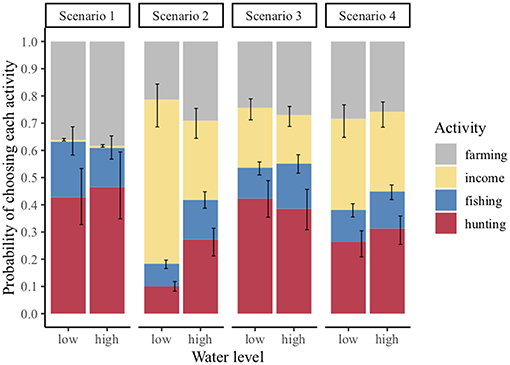
Figure 6. Probability of choosing each activity at every season and scenarios with money availability held constant at the sample mean. The confidence intervals are the 95th percentile intervals, as calculated from the posterior samples of the model. In gray is the reference level (farming).
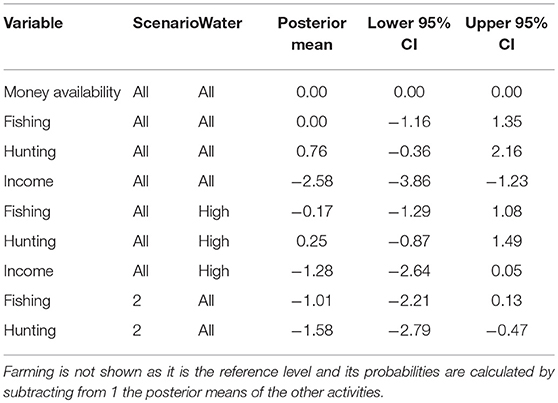
Table 2. MCMC results for the multinomial regression: we report the posterior mean and the 95% credible interval for energy budget allocation model.
Across the nine workshops, only one player stopped hunting starting from scenario 2. He was the only non-indigenous player. Except this one case, players never stopped hunting, even when given access to alternative sources of protein and income.
Hunting Territory Selection
The territory model examined where players who allocated energy to hunting, chose to go hunting. As shown in Figure 7, territory selection varied between seasons within scenarios and between scenarios. Overall, players allocated more energy to territory 2 and less energy to territories 3 and 4 compared to territory 1, our reference level (Table 3). If we compare between seasons, independently of the scenario, territory 2 was less visited during high water compared to territory 1, while territories 3 and 4 were more visited.
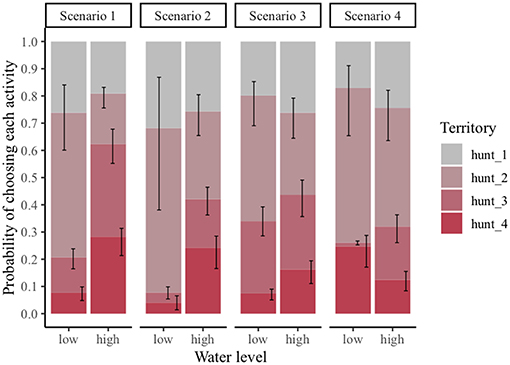
Figure 7. Probability of choosing each hunting territory at every season and scenarios with money availability held constant at the sample mean. The confidence intervals are the 95th percentile intervals, as calculated from the posterior samples of the model. In gray is the reference level (hunting in territory 1).
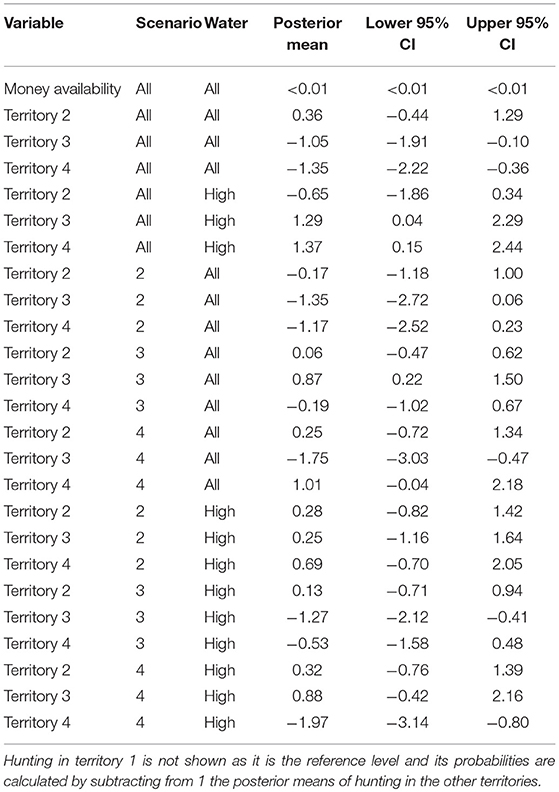
Table 3. We report the posterior mean and the 95% credible interval for the territory selection model.
In both scenarios 1 and 2, during the low water season players had a higher probability to hunt in territories 1 and 2—which are closer to the village—compared to territories 3 and 4—which are further away from the village. When an alternative source of income became available (scenario 2), the probability of visiting territories 3 and 4 substantially decreased compared to scenario 1, meaning that in scenario 2, during low water, players preferred to visit hunting territories closer to the village.
When trade became legal in scenario 3, territory 2 was still the most likely visited territory during the low water season (mean = 45.1%, CI = 36–52.2%). However, there was a 27% (CI = 20.9–31.1%) and 27.7% (CI = 19.2–32.7%) probability of choosing territory 3 in low and high water, respectively, despite the energetic and monetary effort required to reach it when the water is low. Similarly, when competition came in (scenario 4), players had a 24.8% (CI = 16.5–28.9%) chance of visiting territory 4, the farthest of all, during the low water season, and the probability to hunt in this territory never rose above 10% in all other scenarios. On the other hand, the probability of choosing territory 3 in scenario 4 compared to scenario 3 decreased significantly in both seasons.
Choice to Kill
Overall, players drew 215 times a female token from the sacks. In 80% of the cases they wanted to know whether it was pregnant while in the remaining 20% they did not want to know. Out of the 80%, 59 females were not pregnant, 61 were pregnant and 52 escaped the hunter. It is the 61 cases where females were actually pregnant that interested us. In 15% of the cases players decided to kill the female.
Players across all workshops encountered a herd of peccaries only 25 times. Twelve percentage of players did not want to kill any additional individual, 48% killed one extra individual, 20% killed two more, 12% three more and 8% four more.
However, in both cases, there was not enough variation across scenarios and money availability to be detected by the models. Although the sample size was too small to prove any trend, data suggest that if players would have been able to recognize a pregnant female during the hunt, they would, in most cases, not kill it. In the case of the peccaries it seems that most players would kill at least one additional individual but only few would go for a higher catch.
Protein Consumption
It is clear that both the amount of money and wildmeat players had at the end of the round affected their diet (Table 4). When they did not hunt any wildmeat, they did not consume any and only few bought wildmeat from other players (Figure 8). At low levels of income, they had an 80.4% probability of consuming fish (either fished or bought). With increasing income, the probability of consuming industrial meat increased to a maximum of 70.4% (CI = 49.4–84.9%), basically replacing the fish fraction.
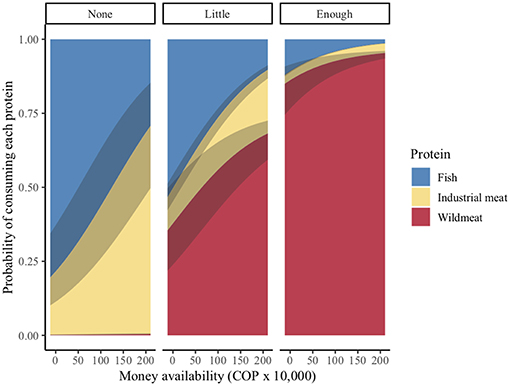
Figure 8. Protein consumption model. The colored areas correspond to the probability of choosing each protein type depending on the amount of money available. The gray areas are the confidence intervals for wildmeat and for industrial meat (fish is the reference level and therefore confidence intervals are not given).
When players did collect some wildmeat (“little”)—though below their protein target—they consumed it and complemented it with fish and/or industrial meat depending on the money availability. The proportion of the protein budget covered with wildmeat ranged from 35.4% (CI = 21.8–49.7%) at low levels of income to 68.2% (CI = 59.4–72.5%) at high levels of income. Despite being constantly lower, industrial meat consumption doubled as well, rising from about 11.2% (CI = 6.8–15.8%) to 21.5% (CI = 18.6–23%) of the total protein intake.
When the wildmeat collected was equal to or higher than the target (“enough”), players mainly consumed wildmeat, independently of the money availability. In this case, wildmeat represented between 85% (CI = 74.5–90.8%) and 95.4% (CI = 93.5–96%) of the total protein intake. Despite the possibility of meeting their protein target with wildmeat only, players consumed a relatively constant amount of industrial meat, ranging between 2.9% (CI = 2.5–3.2%) and 3.2% (CI = 3.1–3.4%) along the income axis. As in all other cases, fish consumption decreased with increasing income, declining from 12–1.4%.
Protein Reward
In the absence of another source of income (scenario 1), wildmeat was the players' main source of income (Figure 9, Table 5). In the presence of an alternative source of income (scenario 2–4), a smaller fraction of players' income came from selling wildmeat. Yet, when wildmeat trading is legal and hunting competition is absent (scenario 3), a substantial fraction of the players' income originated from wildmeat. Across all scenarios, the proportion of income originating from wildmeat and paid jobs fluctuated substantially compared to the relatively constant contribution of fishing and farming. Overall, relatively little money is gained through fishing.
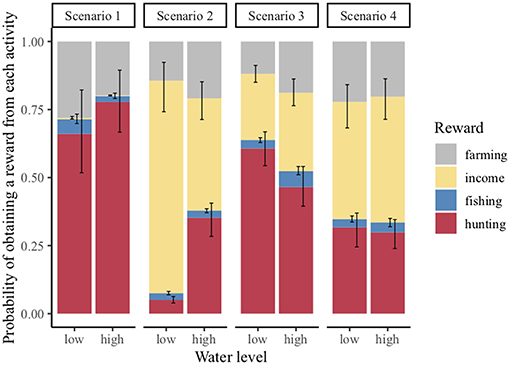
Figure 9. Protein sale model. The colored areas correspond to the probability of selling each protein type at every season and scenario. The confidence intervals are the 95th percentile intervals, as calculated from the posterior samples of the model. In gray is the reference level (reward from farming).
Animal Populations
The only process affecting the animal population was hunting, as defined per game mechanisms. Hunting can not only remove animals from the system but can also stop reproduction if a pregnant female is killed during a round. Carrying capacity could temporarily halt animal reproduction but it was never reached in any of the game workshops and therefore played no role in defining animal abundance.
The animal population models showed that the higher the proportion of energy dedicated to hunting, the lower the population growth rate (Figure 10, Table 6).
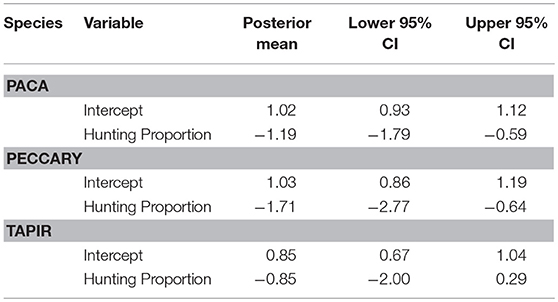
Table 6. We report the posterior mean and the 95% credible interval for the three animal population models.
Discussion
A common concern about experimental games is to what degree what happens under experimental conditions can be extrapolated to explain real-life behavior (Jackson, 2012). For a model to be able to support discussion about the real world, it first needs to seem credible to the users (Checkland, 1995). To ensure the relevance of our game, we designed it, tested it and refined it with the actors of the socio-ecological system we wanted to represent. Gaming and the collective discussions that followed during the debriefing sessions served as triangulation. Players reported that the game represents well the constraints that they have to face in their everyday lives. It created time for self-reflection. “The game gave us the time to analyze our everyday practices and it demonstrated to us that through a game we can understand what is happening in the real world” (Workshop 2, Player ID 2.3). Additionally, most players' decisions departed from the assumptions of maximization and rationality common in economic theory. Players seldom chose the most profitable activities, despite the shortage of money. Similarly, they sold one kind of protein to buy another one at exactly the same price, even though they could have met their target with the initial protein collected. This is a clear example of the difference between the game's internal and external validity. A decision that is consistent with the rules of the game is internally valid. A decision that makes no sense in regard to the rules but has nevertheless a meaning for the players because of their desires, beliefs and intentions they brought from real life is externally valid. Interpreting choices in the game as accurate representations of social realities is risky, even when the game actions match field data (Le Page et al., 2014). More importantly, it is not actually necessary that game choices represent accurately real life behavior (Speelman et al., 2017). The value of the games we use within the ComMod approach lies in their ability to generate collective learning, to foster critical thinking and to encourage creative actions in response to the issues encountered in the game (Checkland, 1995; Le Page et al., 2014). Acknowledging that the game is a tool and not a goal (Verburg et al., 2016), the TICOYA game allowed hunters to hold such in-depth discussions.
The scenarios played in the TICOYA game represent the current situation of the communities included in the study and a glimpse of their potential future. The current reality of the communities lies along a gradient between the first two scenarios. While the context in Puerto Nariño is closer to the one described in scenario 2, some of the most remote communities along the river are still better represented by scenario 1, and most communities are somewhere in between. On the other hand, scenario 3 and 4 represent options that—though plausible—have not occurred yet. Scenario 3 represents the political objective of the hunter's association, scenario 4 a likely outcome threatening community management. When players discuss their strategies in scenarios 1 and 2, they can draw upon real life examples depending on their community of residence. When they move to scenarios 3 and 4, they build their narratives through their values' and aspirations' lenses. While we should not infer directly real-life responses based on the actions in the game, we can nonetheless use the game as a metaphor of reality to foster in-depth discussion on real-life strategies with the hunters.
Brown (2002) hypothesized that providing forest dwellers with income-generating activity and domestic meat would reduce their dependency on wild meat, in turn decreasing hunting pressure. This is supposed to be particularly relevant for South America, where intense livestock production has the potential to cover the protein demand of the Amazon basin (Rushton et al., 2005). Domestic meat, though expensive, is indeed easily found in the grocery shops of Puerto Nariño. In the game, we observed a substantial decrease in hunting effort in scenario 2 compared to scenario 1 when alternative job opportunities and industrial meat become available, supporting the aforementioned hypothesis. Participants in the game workshops confirmed that if offered a job by a logging company or by the town council, they would accept it, especially during the low water season when forest streams and ponds are dry and hunting requires more time and energy investment. Most participants have indeed taken up job opportunities in their everyday life and reduced their hunting effort. Their wages allow them to buy expensive goods that they do not produce themselves but are available in the grocery shops and have become essential in their diets, such as vegetable oil, sugar and rice. During the workshop debriefings, participants claimed that in real life, they would still dedicate some time to hunting—though mainly in territories closer to the villages as they would not have the time anymore to go for longer expeditions deeper into the forest: “If I have a job, I can work during the day and go hunting during the night, it helps saving money” (workshop 4, player ID 4.5). Game results are consistent with players' statements. In scenario 2 they allocated significantly less energy to territories 3 and 4, those farther away from the village, during both seasons.
Participants gave several reasons for not giving up hunting in their everyday lives. First, the jobs that the hunters of the Ticoya reserve have access to are generally short-term and unstable, i.e., employees might have work 1 day but not the next one, and there are often delays for the generally meager payments. After all, hunters with low levels of formal education have little prospects of finding a job. In these conditions, although risky, hunting can be much more profitable than any of the jobs they can get. In addition, hunting offers a safety net for when salary does not come on time or for when it is insufficient to cover all expenses. This reflects the classic strategy of forest dwellers, composed of a mosaic of activities that complement each other at different levels depending on the season and on specific needs (Zenteno et al., 2013). This dynamic structure is one more reason why hunting might be preferred over a regular job whose intrinsic rigidity is less compatible with the agricultural cycle (Brown and Williams, 2003). All except one participant of the game workshops engaged in slash and burn cultivation, an activity that requires high levels of labor inputs at discontinuous times.
Cultural attributes alongside taste preference and diet diversification have also been mentioned in the workshop debriefings to justify the persistence of hunting effort in real life. Participants stated that they hunt because they like the taste of wildmeat and because it allows them to vary from a fish and canned meat diet—the latter considered unhealthy and a threat to traditional practices. Previous studies suggested that wildmeat—although routinely consumed—is not the favored source of animal protein in Amazonian towns (Nardoto et al., 2011; Morsello et al., 2015). However, these studies focused on a random sample of mainly urban households. Participants in our study were all hunters of medium to very small rural settlements who have cultural connections to wildmeat consumption and hunting practices. Some players who, in the game, sold wildmeat to buy industrial meat at the exact same price, justified themselves saying that their children prefer beef and chicken meat over wildmeat. This is in accordance with a previous study on children's preferences which included some of the same rural communities (van Vliet et al., 2015a). One player added, “We abandoned our culture, we are adopting the lifestyle of mestizo people and our children do not want anything to do with our indigenous culture” (workshop 3, player ID 3.4).
Consumption is not driven by cultural attributes only but by income and prices too, with wildmeat consumption falling with the decreasing price of domestic meat and vice versa (Ayres et al., 1991; Wilkie and Godoy, 2001). Economic theory suggests that an increasing income will increase the consumption of a certain good if there are no alternatives or if it is considered a superior good (in which case its consumption would be even higher). Consumption of that specific good would follow an inverted “U”- shaped curve (Kuznets, 1955), increasing up to a tipping point in which consumers—whose income has substantially increased—switch to other products that have become affordable. In our game, an increase in income led to an increase in wildmeat consumption when wildmeat was available. Industrial meat consumption doubled when little wildmeat was available. The increase in wildmeat consumption with increasing income and despite access to alternative products such as fish and industrial meat is an indication that in the game, wildmeat is considered a superior good. However, the parallel increase of industrial meat consumption suggests that we are close to the curve's expected tipping point. Independent of the amount of wildmeat available, consumption of fish constantly decreased with increasing income, suggesting that fish is an inferior good, consumed because there are no affordable substitutes. van Vliet et al. (2015b) support our findings by showing that children have a very low preference for fish compared to other proteins—especially egg and beef.
Understanding the drivers behind wildmeat consumption is essential for designing effective policies for management of wildlife hunting and trading (Schenck et al., 2006). Our results suggest that wildmeat is consumed—and thus hunted—despite the presence of affordable substitutes, although increasing incomes led to increased consumption of industrial meat. The way that players behaved in the game, their statements and their real-life examples suggest that economic development—the availability of alternative sources of income and of protein—could drive the consumption of wildmeat either up or down depending on the initial level of income. Empirical case studies show both trajectories in which additional incomes and changes in market prices decreased reliance on wildmeat (Ayres et al., 1991; Wilkie and Godoy, 2001), or increased it because of better access to more effective hunting equipment (Damania et al., 2005), or had no significant effect on resource exploitation (Torell et al., 2010).
Our results also indicate a more immediate impact of income alternatives on the spatial footprint of hunting. As workshop participants themselves admitted, if they had a job they would concentrate their hunting effort in areas easily reachable from the village—especially during the dry season when accessing more remote regions by boat is not possible. This situation would put additional pressure on an area already affected by habitat fragmentation and human disturbance (e.g., slash and burn agriculture, logging and noise). The lack of hunting heterogeneity over time and space could cause local wildlife populations to deplete over time and could prevent it from being replenished from other less hunted populations (Van Vliet et al., 2010).
In the game as in reality, the risk of getting the meat confiscated when players decided to sell is very low. Out of the 40 participants, only two players had had their wildmeat confiscated within the game, while seven of them stated that they have been confiscated in real life. Most trade occurs locally within the communities and none of the participants bring the meat to the department capital where control is much stricter (van Vliet et al., 2015c). When trade became legal (scenarios 3 and 4), players carried away a guided thought experiment since, though they aspire to it, they have never experienced legal trade first hand and their narratives are not based on concrete practices but on their values and aspirations only. Within the game, hunting effort substantially increased in both seasons once trade became legal. It increased particularly in the most distant territories from the community, territories 3 and 4, during the low water season. This is an indication that despite the cost and effort, players perceived hunting as worthier than other activities. When trade was illegal (scenario 2), hunting effort was significantly lower but, although income could be easily obtained through a regular salary, wildmeat was still sold—especially during the high-water season.
Sustainable wildlife management is gaining recognition under the assumption that a more flexible framework that takes into account the rights and the knowledge of local communities would enhance both conservation and human welfare (Miller et al., 2011). Acknowledging and strengthening the engagement of the human dimension is considered crucial for effective conservation decision-making (Bennett et al., 2016). Despite a general consensus toward sustainable use, wildmeat trade is still strongly criminalized in Colombia and forest dwellers are forced to walk a fine line between subsistence hunting and illegal trade prosecutable by law (van Vliet and Gomez, 2015). Overlooking the role that wildmeat plays in the food security, family economy and cultural identity of rural communities poses a problem for communities and might well be detrimental for the wildlife itself (Nasi et al., 2008). Our results show that players sold wildmeat independently of whether the trade was legal or not. Participants confirmed that they do often sell part of their harvest, a fact also shown by a previous study that included hunters from Puerto Nariño (van Vliet et al., 2014b). The customers are generally neighbors and other community members or, more rarely, restaurants in Puerto Nariño.
A common concern among conservationists is that legalizing wildmeat trade could increase hunting pressure by legitimizing potentially unsustainable levels of hunting, leading affected populations to extirpation (Wilkie et al., 2006). Of the 40 participants, only eight said that they would not hunt more if the wildmeat trade became legal because they hunt for the subsistence of their family and they are concerned with the animals' long-term viability. The other 32 participants declared they would indeed hunt more, endorsing what happened in the game where hunting effort was higher in scenario 3 compared to scenario 2. For most, legal trade would represent an opportunity to have an extra income for everyday necessities. This shows how the concept of subsistence for rural communities has a wider meaning compared to the official definition (Law 84 of 1989, article 30), which restricts legal wildlife use to food provision for the hunter and his/her family. Only three participants mentioned commercial hunting, and the possibility of selling large quantities of wildmeat at the market.
In the scenario 4, we introduced in the game some of the changes that the legality of the trade might bring, such as higher prices for hunting equipment and external competition. Most participants, when confronted with the new circumstances, declared they were not aware of the conditions that legal trade could entail. Taxation and competition had a negative effect on the game's hunting effort, which significantly decreased, though the effect was not equal for all territories. Players reacted to competition by allocating some of their time to a paid job, which again increased in popularity compared to the previous scenario without external players. However, no particular action was taken against the competing hunters that invaded the territory—except for a few occasions in which players rushed to draw animal tokens before the external competitors. Indigenous hunters in this region have implicit norms that regulate hunting access to the forest adjacent to the communities. These rules transcend national borders and are implemented by all neighboring communities, whether they are in Colombia, Perú or Brazil. The competition issue seems to arise only when intruders come from other regions.
The game and the scenarios explored within this study have been designed according to the context of the Ticoya indigenous reserve in Colombia. However, the guiding hypotheses are relevant for most tropical and sub-tropical regions where hunting and trade of wildmeat persists (Milner-Gulland et al., 2003; Brashares et al., 2011). In the Congo basin, for example, people also hunt wildmeat for food—whether directly consumed or sold to third parties—but extraction rates are higher compared to the less studied Amazon basin (Nasi et al., 2011). While rural consumption patterns in the two basins are comparable (Nasi et al., 2011), the rates are different at the urban level. Despite increasing acknowledgment of South American wildmeat urban consumption (Parry et al., 2014; van Vliet et al., 2014a, 2015a), the volumes of trade and consumption in African cities have yet to be overcome (Wilkie et al., 2005; Mbete et al., 2011). This is also due to the smaller livestock production of many Central African countries compared to South America and the consequent lack of valuable alternative sources of protein and income (Rushton et al., 2005; Bennett et al., 2007). We expect our results to be similar—though more trade-focused—in the African context given similar socio-economic conditions of the study area, such as distance to the next urban settlement. Despite differences at the market and institutional level, the forest dwellers of the tropics are facing comparable challenges and opportunities. Over the long term, we expect hunters—in Colombia as well as in other tropical regions—to benefit from the increasingly available alternative livelihoods but at the same time to be lured by a bigger and more accessible market for wildmeat products. The sustainable use of wildlife has the potential to tip the balance toward long-term conservation while at the same time providing a legal source of income and protein.
The aim of this study was to explore hunters' behavior within the environment of a game setting and relate them to their everyday practices, while eliciting individual and collective values, attitudes and aspirations. Specifically, we looked at the effects of policy interventions that are already partially in place in the Amazon region (alternative livelihoods) or that are strongly demanded by local communities (trade legalization). Our results support the hypothesis that providing alternatives would indeed decrease overall hunting effort but might also focus its footprint on smaller areas, canceling the positive effects of temporal and spatial hunting heterogeneity. Legalizing trade could encourage commercial and therefore less sustainable hunting, except when increased prices and competition make it less attractive. This is so unless communities self-organize to control practices and exclude free riders.
Ultimately, for policies to be effective, they need to take into account the coping strategies of the people they are directed to. Our game proved to be a powerful tool to this end, capable of generating a safe and inclusive environment for stakeholders to discuss pressing yet delicate issues such as illegal trade and unsustainable hunting. Within and after the game, people do not fear being explicit about what drives their actions and, eventually, the whole system.
Data Availability
The raw data supporting the conclusions of this manuscript will be made available by the authors, without undue reservation, to any qualified researcher.
Author Contributions
NP co-designed the study, collected data, performed the analysis, and wrote the manuscript. TC led the statistical analysis, provided figures, contributed ideas and reviewed. AD contributed to study design and ideas, provided figures, and reviewed. NvV contributed to study design and ideas. PW contributed to study design, ideas and reviewed. CG co-designed the study, contributed to ideas and reviewed.
Funding
This work was supported by ETH Research Grant ETH-02 15-1.
Conflict of Interest Statement
The authors declare that the research was conducted in the absence of any commercial or financial relationships that could be construed as a potential conflict of interest.
Acknowledgments
The authors are grateful to the hunting association Airumaküchi, CIFOR, Fundación Science International and Fundación Omacha for sharing their data and their expertise and for their support in the field. We are grateful to the hunters of Amazonas, for dedicating their time, energy and knowledge to this project. We thank John Garcia Ulloa for creating the study area map.
Supplementary Material
The Supplementary Material for this article can be found online at: https://www.frontiersin.org/articles/10.3389/fevo.2019.00034/full#supplementary-material
References
Andrade, G. S. M., and Rhodes, J. R. (2012). Protected areas and local communities: an inevitable partnership toward successful conservation strategies? Ecol. Soc. 17:14. doi: 10.5751/ES-05216-170414
Ayres, J. M., Lima, D., de, M., and Martins, E. de S. (1991). “On the track of the road: changes in subsistence Hunting in a Brazilian Amazonian Village,” in Neotropical Wildlife Use and Conservation, eds J. Robinson and K. Redford (Chicago: University of Chicago Press), 82–92.
Barreteau, O., Bousquet, F., Etienne, M., Souchère, V., and D'Aquino, P. (2011). “Companion modelling: a method of adaptive and participatory research,” in Companion Modelling. A Participatory Approach to Support Sustainable Development, ed M. Étienne (Dordrecht: Springer), 21–44.
Barrett, C. B., Brandon, K., Gibson, C., and Gjertsen, H. (2001). Conserving Tropical Biodiversity amid Weak Institutions. Bioscience 51, 497–502. doi: 10.1641/0006-3568(2001)051[0497:CTBAWI]2.0.CO;2
Basco-Carrera, L., Warren, A., van Beek, E., Jonoski, A., and Giardino, A. (2017). Collaborative modelling or participatory modelling? A framework for water resources management. Environ. Model. Softw. 91, 95–110. doi: 10.1016/j.envsoft.2017.01.014
Benítez-López, A., Alkemade, J. R. M., Schipper, A. M., Ingram, D. J., Verweij, P. A., Eikelboom, J. A. J., et al. (2017). The impact of hunting on tropical mammal and bird populations. Science 356, 180–183. doi: 10.1126/science.aaj1891
Bennett, E., and Robinson, J. (2000). Hunting of Wildlife in Tropical Forests - Implications for Biodiversity and Forest Peoples. Washington, DC.
Bennett, E. L., Blencowe, E., Brandon, K., Brown, D., Burn, R. W., Cowlishaw, G., et al. (2007). Hunting for consensus: reconciling bushmeat harvest, conservation, and development policy in West and Central Africa. Conserv. Biol. 21, 884–887. doi: 10.1111/j.1523-1739.2006.00595.x
Bennett, N. J., Roth, R., Klain, S. C., Chan, K., Christie, P., Clark, D. A., et al. (2016). Conservation social science: understanding and integrating human dimensions to improve conservation. Biol. Conserv. 205, 93–108. doi: 10.1016/j.biocon.2016.10.006
Bennett, N. J., Roth, R., Klain, S. C., Chan, K. M. A., Clark, D. A., Cullman, G., et al. (2017). Mainstreaming the social sciences in conservation. Conserv. Biol. 31, 56–66. doi: 10.1111/cobi.12788
Berkes, F. (2004). Rethinking community-based conservation. Conserv. Biol. 18, 621–630. doi: 10.1111/j.1523-1739.2004.00077.x
Bodmer, R. E., and Lozano, E. P. (2001). Rural development and sustainable wildlife use in Peru. Conserv. Biol. 15, 1163–1170. doi: 10.1046/j.1523-1739.2001.0150041163.x
Bodonirina, N., Reibelt, L., Stoudmann, N., Chamagne, J., Jones, T., Ravaka, A., et al. (2018). Approaching local perceptions of forest governance and livelihood challenges with companion modeling from a case study around Zahamena National Park, Madagascar. Forests 9:624. doi: 10.3390/f9100624
Bolker, B. M., Brooks, M. E., Clark, C. J., Geange, S. W., Poulsen, J. R., Stevens, M. H. H., et al. (2009). Generalized linear mixed models: a practical guide for ecology and evolution. Trends Ecol. Evol. 24, 127–135. doi: 10.1016/j.tree.2008.10.008
Bousquet, F., Le Page, C., Bakam, I., and Takforyan, A. (2001). Multiagent simulations of hunting wild meat in a village in eastern Cameroon. Ecol. Model. 138, 331–346. doi: 10.1016/S0304-3800(00)00412-9
Brandon, K., Redford, K., and Sanderson, S. E. (1998). “Parks in Peril,” in People, Politics and Protected Areas, ed The Nature Conservancy (Washington DC: Island Press) 137–139.
Brashares, J. S., Golden, C. D., Weinbaum, K. Z., Barrett, C. B., and Okello, G. V. (2011). Economic and geographic drivers of wildlife consumption in rural Africa. Proc. Natl. Acad. Sci. U.S.A. 108, 13931–13936. doi: 10.1073/pnas.1011526108
Brockington, D., and Wilkie, D. (2015). Protected areas and poverty. Philos. Trans. R. Soc. B Biol. Sci. 370:20140271. doi: 10.1098/rstb.2014.0271
Brown, D., and Williams, A. (2003). The case for bushmeat as a component of development policy: issues and challenges. Int. For. Rev. 5, 148–155. doi: 10.1505/IFOR.5.2.148.17414
Brown, K. (2002). Innovations for conservation and development. Geogr. J. 168, 6–17. doi: 10.1111/1475-4959.00034
Checkland, P. (1995). Model validation in soft systems practice. Syst. Res. 12, 47–54. doi: 10.1002/sres.3850120108
Damania, R., Milner-Gulland, E. J., and Crookes, D. J. (2005). A bioeconomic analysis of bushmeat hunting. Proc. Biol. Sci. 272, 259–266. doi: 10.1098/rspb.2004.2945
de Thoisy, B., da Silva, A. G., Ruiz-García, M., Tapia, A., Ramirez, O., Arana, M., et al. (2010). Population history, phylogeography, and conservation genetics of the last Neotropical mega-herbivore, the lowland tapir (Tapirus terrestris). BMC Evol. Biol. 10:278. doi: 10.1186/1471-2148-10-278
Duffy, R., John, F. A. V. S., Bram, B., and Brockington, D. (2016). Toward a new understanding of the links between poverty and illegal wildlife hunting. Conserv. Biol. 30, 14–22. doi: 10.1111/cobi.12622
Emmons, L. (2016). Cuniculus paca. The IUCN Red List of Threatened Species 2016: e.T699A22197347. doi: 10.2305/IUCN.UK.2016-2.RLTS.T699A22197347.en
Emmons, L. H. (1989). Tropical rain forests: why they have so many species and how we may lose this biodiversity without cutting a single tree. Orion 8, 8–14.
Étienne, M. (2013). Companion Modelling: A Participatory Approach to Support Sustainable Development. Available online at: https://books.google.ch/books?hl=enandlr=lang_enandid=jnzGBAAAQBAJandoi=fndandpg=PR7anddq
=%22Role+playing+game%22+AND+%22Natural+Resource+Management
%22andots=t9XXrNklc7andsig=ekLXfxO3GfLQndRHKWT3thUgPaE (Accessed February 24, 2017).
Etienne, M. (2014). Companion Modelling - A Participatory Approach to Support Sustainable Development. Dordrecht: Springer. 16, 1–44.
Etienne, M., Toit, D., Du, P.ollard, S., du Toit, D. R., and Pollard, S. (2011). ARDI: A co-construction method for participatory modeling in natural resources management. Ecol. Soc. 16. doi: 10.5751/ES-03748-160144
Fa, J. E., Peres, C. A., and Meeuwig, J. (2002). Bushmeat exploitation in tropical forests: an intercontinental comparison\ rexplotación de carne silvestre en bosques tropicales: una comparación intercontinental. Conserv. Biol. 16, 232–237. doi: 10.1046/j.1523-1739.2002.00275.x
Feintrenie, L., Schwarze, S., and Levang, P. (2010). Are local people conservationists? analysis of transition dynamics from agroforests to monoculture plantations in Indonesia. Ecol. Soc. 15:37. doi: 10.5751/ES-03870-150437
Franco, R. (2006). El Proceso del REM en el Sector Sur del Parque Amacayacu. Bogotá: Parques Nacionales Naturales de Colombia.
Garcia, C. A., Bhagwat, S. A., Ghazoul, J., Nath, C. D., Nanaya, K. M., Kushalappa, C. G., et al. (2010). Biodiversity conservation in agricultural landscapes: challenges and opportunities of coffee agroforests in the western ghats, India. Conserv. Biol. 24, 479–488. doi: 10.1111/j.1523-1739.2009.01386.x
Garcia, C. A., Dray, A., and Waeber, P. (2016). Learning begins when the game is over. GAIA 25, 289–291. doi: 10.14512/gaia.25.4.13
Gelman, A., and Rubin, D. B. (1992). Inference from Iterative Simulation Using Multiple Sequences. Stat. Sci. 7, 457–472. doi: 10.1214/ss/1177011136
Gottdenker, N., and Bodmer, R. E. (1998). Reproduction and productivity of white-lipped and collared peccaries in the peruvian Amazon. J. Zool. 245, 423–430. doi: 10.1111/j.1469-7998.1998.tb00116.x
Hadfield, J. D. (2010). MCMC methods for multi-response generalized linear mixed models: the MCMCglmm R package. J. Stat. Softw. 33, 1–22. doi: 10.18637/jss.v033.i02
INEI (2010). Análisis Etnosociodemográfico de las Comunidades Nativas de La Amazonía. Lima: Instituto Nacional de Estadística e Informática (INEI).
Jackson, C. (2012). Internal and external validity in experimental games: a social reality check. Eur. J. Dev. Res. 24, 71–88. doi: 10.1057/ejdr.2011.47
Keuroghlian, A., Reyna-Hurtado, R., Altrichter, M., Beck, H., Taber, A., and Fragoso, J. M. V. (2013). Tayassu pecari. The IUCN Red List of Threatened Species. 2013:e.T41778A44051115. doi: 10.2305/IUCN.UK.2013-1.RLTS.T41778A44051115.en
Koster, J., and McElreath, R. (2017). Multinomial analysis of behavior: statistical methods. Behav. Ecol. Sociobiol. 71:138. doi: 10.1007/s00265-017-2363-8
Kurten, E. L. (2013). Cascading effects of contemporaneous defaunation on tropical forest communities. Biol. Conserv. 163, 22–32. doi: 10.1016/j.biocon.2013.04.025
Le Page, C., Abrami, G., Barreteau, O., Becu, N., Bommel, P., Botta, A., et al. (2014). “Models for Sharing Representations,” in Companion Modelling: A Participatory Approach to Support Sustainable Development, ed. M. Étienne (Dordrecht: Springer Netherlands), 69–101.
Le Page, C., Bobo, K. S., Kamgaing, T. O. W., Ngahane, B. F., and Waltert, M. (2015). Interactive simulations with a stylized scale model to codesign with villagers an agent-based model of bushmeat hunting in the periphery of korup National Park (Cameroon). J. Artif. Soc. Soc. Simul. 18, 1–14. doi: 10.18564/jasss.2550
Levi, T., Shepard, G. H., Ohl-Schacherer, J., Peres, C. A., and Yu, D. W. (2009). Modelling the long-term sustainability of indigenous hunting in Manu National Park, Peru: landscape-scale management implications for Amazonia. J. Appl. Ecol. 46, 804–814. doi: 10.1111/j.1365-2664.2009.01661.x
Ling, S., and Milner-Gulland, E. J. (2006). Assessment of the sustainability of bushmeat hunting based on dynamic bioeconomic models. Conserv. Biol. 20, 1294–1299. doi: 10.1111/j.1523-1739.2006.00414.x
Maldonado, A. (2010). The Impact of Subsistence Hunting by Tikunas on Game Species in Amacayacu National Park, Colombian Amazon.
Marrocoli, S., Tagesse, T., Morgan, D., Reinhardt, M., and Kühl, H. (2018). Environmental uncertainty and self-monitoring in the commons : a common-pool resource experiment framed around bushmeat hunting in the republic of Congo. Ecol. Econ. 149, 274–284. doi: 10.1016/j.ecolecon.2018.03.020
Mathevet, R., Page, C., Le, E.tienne, M., Le Page, C., and Etienne, M., Lefebvre, G., et al. (2007). BUTORSTAR: A role-playing game for collective awareness of wise reedbed use. Simul. Gaming 38, 233–262. doi: 10.1177/1046878107300665
Mbete, R. A., Banga-Mboko, H., Racey, P., Mfoukou-Ntsakala, A., Nganga, I., Vermeulen, C., et al. (2011). Household bushmeat consumption in Brazzaville, the Republic of the Congo. Trop. Conserv. Sci. 4, 187–202. doi: 10.1177/194008291100400207
McCulloch, C. E., and Searle, S. R. (2001). Generalized, Linear, and Mixed Models. New York, NY: Wiley
Miller, T. R., Minteer, B. A., and Malan, L. C. (2011). The new conservation debate: the view from practical ethics. Biol. Conserv. 144, 948–957. doi: 10.1016/j.biocon.2010.04.001
Milner-Gulland, E. J., Bennett, E. L., Abernethy, K., Bakarr, M., Bennett, E., Bodmer, R., et al. (2003). Wild meat: the bigger picture. Trends Ecol. Evol. 18, 351–357. doi: 10.1016/S0169-5347(03)00123-X
Moreno Arocha, M. (2014). “Descripción Geográfica,” in Los Humedales de Tarapoto: Aportes al Conocimiento Sobre su Biodiversidad y uso, eds F. Trujillo and R. S. Duque (Leticia: Fundación Omacha, Corpoamazonia, Universidad Nacional Sede Leticia), 400.
Morsello, C., Yagüe, B., Beltreschi, L., van Vliet, N., Adams, C., Schor, T., et al. (2015). Cultural attitudes are stronger predictors of bushmeat consumption and preference than economic factors among urban amazonians from brazil and colombia. Ecol. Soc. 20:21.
Nardoto, G. B., Murrieta, R. S. S., Prates, L. E. G., Adams, C., Garavello, M. E. P. E., Schor, T., et al. (2011). Frozen chicken for wild fish: nutritional transition in the Brazilian Amazon region determined by carbon and nitrogen stable isotope ratios in fingernails. Am. J. Hum. Biol. 23, 642–650. doi: 10.1002/ajhb.21192
Nasi, R., Brown, D., Wilkie, D., Bennett, E., Tutin, C., van Tol, G., et al. (2008). Conservation and Use of Wildlife-Based Resources: the Bushmeat Crisis. Bogor: Secretariat of the Convention on Biological Diversity.
Nasi, R., Taber, A., and van Vliet, N. (2011). Empty forests, empty stomachs? Bushmeat and livelihoods in the Congo and Amazon Basins. Int. For. Rev. 13, 355–368. doi: 10.1505/146554811798293872
Naveda, A., de Thoisy, B., Richard-Hansen, C., Torres, D., Salas, L., Wallance, R., et al. (2008). Tapirus terrestris. The IUCN Red List Threatened Species. 2008:e.T21474A9285933. doi: 10.2305/IUCN.UK.2008.RLTS.T21474A9285933.en
Nielsen, M. R., Meilby, H., Smith-Hall, C., Pouliot, M., and Treue, T. (2018). The importance of wild meat in the Global South. Ecol. Econ. 146, 696–705. doi: 10.1016/j.ecolecon.2017.12.018
Ojasti, J. (1996). Wildlife Utilization in Latin America: Current Situation and Prospects for Sustainable Management. Rome. Available online at: http://www.fao.org/docrep/t0750e/t0750e00.htm
Ortiz, S. (1984). “Colonization of the Colombian Amazon,” in Frontier expansion in Amazonia, eds. M. Schmink and C. H. Hood (Gainesville: University of Florida Press), 204–230.
Parry, L., Barlow, J., and Pereira, H. (2014). Wildlife Harvest and consumption in amazonia's urbanized Wilderness. Conserv. Lett. 7, 565–574. doi: 10.1111/conl.12151
Peres, C. A. (2007). Peres, C. A., and Palacios, E. (2007). Basin-wide effects of game harvest on vertebrate population densities in amazonian forests implications for animal-mediated seed dispersal. Biotropica 39, 304–315. doi: 10.1111/j.1744-7429.2007.00272.x
Plummer, M., Best, N., Cowles, K., and Vines, K. (2006). CODA: Convergence Diagnosis and Output Analysis for MCMC. R News.
PNNA (2006). Línea Base del Parque Nacional Natural Amacayacu. Leticia: Parques Nacionales Naturales de Colombia.
Quiceno-Mesa, M. P., Cruz-Antia, D., Moreno, J., and van Vliet, N. (2014). “Descripción de la cacería y consumo de carne de monte en el río Loretoyacu y el lago Tarapoto, Puerto nariño,” in Los Humedales de Tarapoto Aportes al Conocimiento Sobre su Biodiversidad y Uso, eds F. Trujillo and S. Duque (Bogotá: Fundación Omacha).
R Core Team (2018). R: A Language and Environment for Statistical Computing. Available online at: https://www.r-project.org
Redford, K., and Feinsinger, P. (2003). “The half-empty forest: Sustainable use and the ecology of interactions,” in Conservation of Exploited Species, eds J. Reynolds, G. Mace, K. H. Redford, and J. G. Robinson (Cambridge, UK: Cambridge University Press), 370–399.
Redpath, S. M., Keane, A., Andrén, H., Baynham-Herd, Z., Bunnefeld, N., Duthie, A. B., et al. (2018). Games as tools to address conservation conflicts. Trends Ecol. Evol. 33, 415–426. doi: 10.1016/j.tree.2018.03.005
Reibelt, L. M., Moser, G., Dray, A., Randriamalala, I. H., Chamange, J., Ramamonjisao, B., et al. (2017). Tool development to understand rural resource users ‘land use and impacts on land type changes in Madagascar. Madag. Conserv. Dev. XX, 1–10. doi: 10.4314/mcd.wetlands.3
Riaño, E. (2003). Organizando su espacio, construyendo su territorio. Transformaciones de los asentamientos Ticuna en la ribera del Amazonas colombiano. Bogotá: Universidad Nacional de Colombia.
Ripple, W. J., Abernethy, K., Betts, M. G., Chapron, G., Dirzo, R., Galetti, M., et al. (2016). Bushmeat hunting and extinction risk to the world' s mammals. R. Soc. Open Sci. 3:160498. doi: 10.1098/rsos.160498
Robinson, J., and Bennett, E. (2000). Hunting for Sustainability in Tropical Forests. New York, NY: Columbia University Press.
Robinson, J. G., and Redford, K. H. (1986). Intrinsic rate of natural increase in Neotropical forest mammals: relationship to phylogeny and diet. Oecologia 68, 516–520. doi: 10.1007/BF00378765
Roe, D., Booker, F., Day, M., Zhou, W., Webb, S. A., Hill, N. A. O., et al. (2015). Are alternative livelihood projects effective at reducing local threats to specified elements of biodiversity and / or improving or maintaining the conservation status of those elements ? Environ. Evid. 3, 1–22. doi: 10.1186/2047-2382-3-6
Ruiz, A. (2008). Coordinación General del Plan de Desarrollo: diseño, elaboración y formulación año 2008. Puerto Nariño: Alcaldía Municipal de Puerto Nariño.
Rushton, J., Viscarra, R., Viscarra, C., Basset, F., Baptista, R., and Brown, D. (2005). How important is bushmeat consumption in South America: now and in the future? Odi Wildl. Policy Br. 11, 1–4.
Sandrin, F., L'haridon, L., Vanegas, L., Ponta, N., Gómez, J., Cuellar, J. R, et al. (2016). Manejo comunitario de la cacería y de la fauna: Avances realizados por la asociación de cazadores airumaküchi en Puerto Nariño, Amazonas Colombia. Los Documentos de trabajo 213. Bogor: CIFOR. doi: 10.17528/cifor/006286
Schenck, M., Nsame Effa, E., Starkey, M., Wilkie, D., Abernethy, K., Telfer, P., et al. (2006). Why people eat bushmeat: results from two-choice, taste tests in Gabon, Central Africa. Hum. Ecol. 34, 433–445. doi: 10.1007/s10745-006-9025-1
Schor, T., and da Costa Avelino, F. (2017). Geography of Food and the Urban Network in the Tri-Border Brazil-Peru-Colombia : the case of production and commercialization of poultry in the amazon. Cuad. Geogr. Rev. Colomb. Geogr. 26, 141–154. doi: 10.15446/rcdg.v26n1.52301
Smith, D. A. (2005). Garden game: shifting cultivation, indigenous hunting and wildlife ecology in western Panama. Hum. Ecol. 33, 505–537. doi: 10.1007/s10745-005-5157-Y
Speelman, E. N., van Noordwijk, M., and Garcia, C. (2017). “Gaming to better manage complex natural resource landscapes,” in Co-investment in Ecosystem Services: Global Lessons from Payment and Incentive Schemes (Nairobi: World Agroforestry Centre (ICRAF)), 480–489.
Spiegelhalter, D. J., Best, N. G., Carlin, B. P., and Van Der Linde, A. (2002). Bayesian measures of model complexity and fit. J. R. Stat. Soc. Ser. B Stat. Methodol. 64, 583–563. doi: 10.1111/1467-9868.00353
Stöckli, B., Wiesmann, U., and Lys, J. A. (2012). A Guide for Transboundary 11 Principles. Bern. Available online at: http://www.naturalsciences.ch/organisations/kfpe/11_principles_7_questions
Torell, E., Crawford, B., Kotowicz, D., Herrera, M. D., and Tobey, J. (2010). Moderating our expectations on livelihoods in ICM: experiences from Thailand, Nicaragua, and Tanzania. Coast. Manag.38, 216–237. doi: 10.1080/08920753.2010.483166
Trujillo, C. (2008). Selva y Mercado: Exploración Cuantitativa de los Ingresos en Hogares Indígenas. Leticia, Amazonas: Master thesis in Amazonian Studies, Universidad Nacional de Colombia, Sede Amazonia.
van Vliet, N. (2011). Livelihood Alternatives for the Unsustainable Use of Bushmeat. Secretariat of the Convention on Biological Diversity.
van Vliet, N. (2016). Colombia: Moving Towards Sustainable Hunting and Legal Bushmeat Trade. Montreal, QC: Secretariat of the Convention on Biological Diversity
van Vliet, N., Cruz, D., Quiceno-Mesa, M. P., De Aquino, L. J. N., Moreno, J., Ribeiro, R., et al. (2015a). Ride, shoot, and call: wildlife use among contemporary urban hunters in tres Fronteiras, Brazilian Amazon. Ecol. Soc. 20:8. doi: 10.5751/ES-07506-200308
van Vliet, N., Fa, J., Nasi, R., van Vliet, N., Fa, J., and Nasi, R. (2015b). Managing hunting under uncertainty : from one-off ecological indicators to resilience approaches in assessing the sustainability of bushmeat hunting. Ecol. Soc. 20:7. doi: 10.5751/ES-07669-200307
van Vliet, N., and Gomez, J. (2015). Sustainable wildlife management and legal commercial use of bushmeat in Colombia: the resource remains at the cross-road. Int. For. 17, 438–447. Available at: http://www.ingentaconnect.com/content/cfa/ifr/2015/00000017/00000004/art00005.
van Vliet, N., Hernandez, S., and Moreno, J. (2014a). Bushmeat in the tri-Frontier Region of Brazil , Peru and Colombia Demise or Persistence? Bogor: CIFOR.
van Vliet, N., L'haridon, L., Gomez, J., Vanegas, L., Sandrin, F., and Nasi, R. (2018). The Use of Traditional Ecological Knowledge in the Context of Participatory Wildlife Management: Examples from Indigenous Communities in Puerto Nariño, Amazonas-Colombia. Ethnozoology 2018, 497–512. doi: 10.1016/B978-0-12-809913-1.00026-0
Van Vliet, N., Milner-Gulland, E. J., Bousquet, F., Saqalli, M., and Nasi, R. (2010). Effect of Small-Scale heterogeneity of prey and hunter distributions on the sustainability of bushmeat hunting. Conserv. Biol. 24, 1327–1337. doi: 10.1111/j.1523-1739.2010.01484.x
van Vliet, N., Quiceno-Mesa, M. P., Cruz-Antia, D., Jonhson, L., Aquino, N., and De M.oreno, J., et al. (2014b). The uncovered volumes of bushmeat commercialized in the Amazonian trifrontier between Colombia, Peru and Brazil. Ethnobiol. Conserv. 7, 1–11. doi: 10.15451/ec2014-11-3.7-1-11
van Vliet, N., Quiceno-Mesa, M. P., Cruz-Antia, D., Neves de Aquino, L. J., Yagüe, B., Schor, T., et al. (2015c). Bushmeat networks link the forest to Urban areas in the trifrontier region between Brazil, Colombia, and Peru. Ecol. Soc. 20. doi: 10.17528/cifor/005363
van Vliet, N., Quiceno-Mesa, M. P., Cruz-Antia, D., Tellez, L., Martins, C., Haiden, E., et al. (2015d). From fish and bushmeat to chicken nuggets: the nutrition transition in a continuum from rural to urban settings in the Colombian Amazon region. Ethnobiol. Conserv. 4:6. doi: 10.15451/ec2015-7-4.6-1-12
van Vliet, N., Quiceno-Mesa, M. P., Cruz-Antia, D., and Yague, B. (2014c). Carne de Monte y Seguridad Alimentaria en la zona Trifronteriza Amazónica. Bogotá: CGIAR, USAID, CIFOR, Fundación SI, UFAM, Fundación Omacha.
Verburg, P. (2006). Simulating feedbacks in land use and land cover change models. Landsc. Ecol. Available online at: http://www.springerlink.com/index/G65X588HP5122477.pdf [Accessed February 24, 2017].
Verburg, P. H., Dearing, J. A., Dyke, J. G., Leeuw, S., van der, Seitzinger, S., Steffen, W., et al. (2016). Methods and approaches to modelling the Anthropocene. Glob. Environ. Change 39, 328–340. doi: 10.1016/j.gloenvcha.2015.08.007
Weinbaum, K. Z., Brashares, J. S., Golden, C. D., and Getz, W. M. (2013). Searching for sustainability: are assessments of wildlife harvests behind the times? Ecol. Lett. 16, 99–111. doi: 10.1111/ele.12008
WHO. (1991). Energy and Protein Requirements: Report of a Joint FAO/WHO Ad Hoc Expert Committee. Geneva.
Wilkie, D. S., and Godoy, R. A. (2001). Income and price elasticities of bushmeat demand in lowland Amerindian societies. Conserv. Biol. 20:19. doi: 10.1046/j.1523-1739.2001.015003761.x
Wilkie, D. S., Starkey, M., Abernethy, K., Effa, E. N., Telfer, P., and Godoy, R. (2005). Role of prices and wealth in consumer demand for bushmeat in Gabon, Central Africa. Conserv. Biol. 19, 268–274. doi: 10.1111/j.1523-1739.2005.00372.x
Wilkie, D. S., Starkey, M., Bennett, E. L., Abernethy, K., Fotso, R., Maisels, F., et al. (2006). Can taxation contribute to sustainable management of the Bushmeat Trade? Evidence from Gabon and Cameroon. J. Int. Wildl. Law Policy 9, 335–349. doi: 10.1080/13880290601039287
Wright, S. J. (2003). The myriad consequences of hunting for vertebrates and plants in tropical forests. Perspect. Plant Ecol. Evol. Syst. 6, 73–86. doi: 10.1078/1433-8319-00043
Xiang, W. N. (2013). Working with wicked problems in socio-ecological systems: awareness, acceptance, and adaptation. Landsc. Urban Plan. 110, 1–4. doi: 10.1016/j.landurbplan.2012.11.006
Zárate, C., and Ahumada, C. (2008). Fronteras en la globalización: localidad, biodiversidad y comercio en la Amazonia. Leticia: Amazonia and Instituto IMANI Observatorio Andino.
Keywords: wildmeat, hunting, role-playing games, wildlife management, Colombia, indigenous, alternative livelihoods, companion modeling
Citation: Ponta N, Cornioley T, Dray A, van Vliet N, Waeber PO and Garcia CA (2019) Hunting in Times of Change: Uncovering Indigenous Strategies in the Colombian Amazon Using a Role-Playing Game. Front. Ecol. Evol. 7:34. doi: 10.3389/fevo.2019.00034
Received: 31 October 2018; Accepted: 29 January 2019;
Published: 28 March 2019.
Edited by:
Enrico Di Minin, University of Helsinki, FinlandReviewed by:
Edson Gandiwa, Chinhoyi University of Technology, ZimbabweHirokazu Yasuoka, Kyoto University, Japan
Copyright © 2019 Ponta, Cornioley, Dray, van Vliet, Waeber and Garcia. This is an open-access article distributed under the terms of the Creative Commons Attribution License (CC BY). The use, distribution or reproduction in other forums is permitted, provided the original author(s) and the copyright owner(s) are credited and that the original publication in this journal is cited, in accordance with accepted academic practice. No use, distribution or reproduction is permitted which does not comply with these terms.
*Correspondence: Nicole Ponta, bmljb2xlLnBvbnRhQHVzeXMuZXRoei5jaA==
 Nicole Ponta
Nicole Ponta Tina Cornioley
Tina Cornioley Anne Dray
Anne Dray Nathalie van Vliet
Nathalie van Vliet Patrick O. Waeber
Patrick O. Waeber Claude A. Garcia
Claude A. Garcia